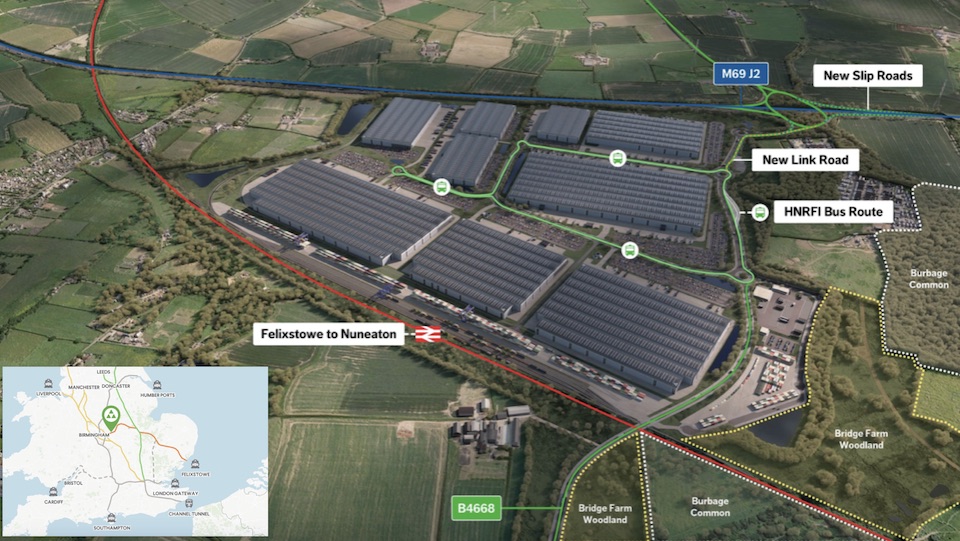Maritime Transport to operate Hinckley National Rail Freight Interchange
Maritime Transport has signed an agreement to operate the Hinckley National Rail Freight Interchange. The integrated road and rail freight logistics provider will develop a 40-acre (16 hectare) site, designated a strategic rail freight interchange by the UK government. The SRFI will be capable of handling 16 trains per day when fully operational.
Developers Tritax Symmetry have invested 750 million pounds (877 million euro) into the Strategic Rail Freight Interchange ('SRFI') at Hinckley National Rail Freight Interchange ('HNRFI'). As part of their exclusive agreement, they have engaged Maritime Transport to commercially develop, lease, and operate the project. Hinckley in Leicestershire sits at the heart of England's so-called "Golden Triangle" for logistics operations.
The park has been both eagerly anticipated and equally ferociously opposed.
Connecting to ports across England
Maritime Transport[1], which claims to be the UK's leading integrated road and rail freight logistics provider, says that when up to capacity of 16 intermodal trains per day, the SRFI will remove more than 83 million HGV (heavy goods vehicle) miles from the UK road network (133 million km). The significant volume of goods switched from road to rail could save around 70,120 tonnes of CO2 each year, say Maritime.
 CGI impression of logistics park warehouses and rail terminal at Hinckley in East Midlands
CGI impression of logistics park warehouses and rail terminal at Hinckley in East Midlands
The new terminal will sit alongside seven million square feet (650,000 square metres) of new warehouse facilities. The rail freight terminal will strengthen connections between the English Midlands and the major English ports of Felixstowe, Liverpool, London Gateway, Southampton, and Teesport.
Maritime also expect to serve Mossend International Railfreight Park in Central Scotland, when that facility comes online. The Port of Felixstowe is the UK's largest container terminal, and is the location of Maritime Transport's headquarters.
Opposition on business and environmental grounds
Although the management agreement has been signed, there is still doubt over the Hinckley development. Local opposition has been dogged[2], to say the least.
The local council administration, and several local stakeholder groups have resisted the development on several grounds, including the business case and environmental impact. There is still some jeopardy over the eventual completing of the project. The scheme remains dependent on the UK Government Secretary of State for Transport to waive aside objections, and grant approval of a legally binding Development Consent Order[3].
The outcome is due in September this year.
Prime location for rail-linked logistics
Meanwhile, the industry partners have greeting the agreement as a significant step forward. "Maritime Transport's commitment to an SRFI at this early stage is a significant first in the sector and reflects ultimate confidence in the location's suitability for rail freight from the leading road and rail freight location provider in the UK", said Jonathan Wallis, Director at Tritax Symmetry[4]. "We are excited by the potential of this prime location for rail-linked logistics, which we believe will see strong demand for large scale, flexible, modern, low carbon space."
 John Williams Group Executive Chair at Maritime transport (Maritime image)
John Williams Group Executive Chair at Maritime transport (Maritime image)
Maritime see Hinckley as a prime opportunity to further develop their rail-based business. "This development will strengthen our rail-connected network and our strategy of decarbonising the full load supply chain in the UK, moving cargo closer to the end user by rail", noted John Williams, Executive Chairman of Maritime Transport. "Our strategy of decarbonising the supply chain will extend to the introduction of BEV (Battery Electric Vehicles) to perform first and final mile transport, creating the most sustainable full load networked, intermodal logistics offering for occupiers at HNRFI and beyond."
Enhance modal shift to rail
Maritime Transport already operates over 40 logistics sites across the UK and has invested significantly in its intermodal offering. Hinckley will add to its portfolio of open-access, multi-user UK rail terminals, including locations at Birmingham, Hams Hall, Kegworth, Manchester, Northampton, London (Tilbury) and Wakefield. Maritime also operates out of existing facilities at Mossend[5], where expansion is underway.
"We are encouraged by Tritax and Maritime's commitment to rail freight", said Maggie Simpson, Director General of the representative organisation, the Rail Freight Group. "This display of support for the UK's latest SRFI before the DCO decision is determined is extremely welcome for advancement of sustainable, rail-based logistics. The development of a national network of strategic rail freight interchanges is paramount to ensuring the long-term future viability of the UK Government's target to enhance modal shift of freight from road to rail."
You just read one of our premium articles free of charge
Want full access? Take advantage of our exclusive offer
References
- ^ Maritime Transport (www.maritimetransport.com)
- ^ opposition has been dogged (www.railfreight.com)
- ^ Development Consent Order (infrastructure.planninginspectorate.gov.uk)
- ^ Tritax Symmetry (www.tritax.co.uk)
- ^ existing facilities at Mossend (www.railfreight.com)
- ^ See the offer (www.railfreight.com)